How to create product detail pages that convert | Our guide to PDP best practice
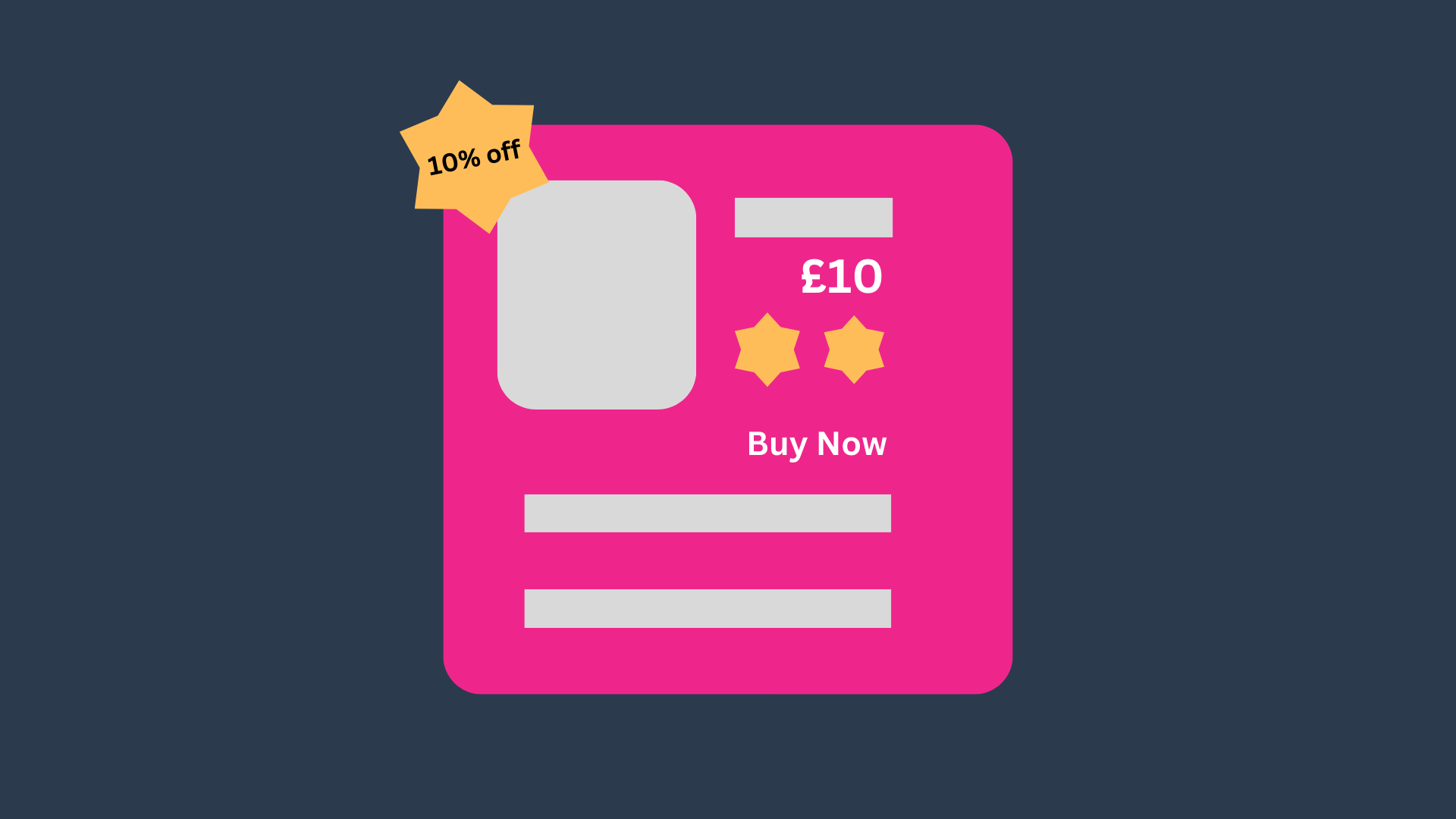
December 21, 2024
An optimised product detail page is essential to effective ecommerce. You’ve worked hard and spent valuable marketing budget to get your customer to the moment before purchase. The last thing you want to do is give them an excuse to click away. In this article we look at how to create product pages that work.
A product detail page (PDP) is the representation of your product online. You can think of it a bit like your product packaging in-store. Its job is to grab the customers attention and tell them why they should pick your product over your competitors.
In a practical sense it is just a dedicated product page on an ecommerce website, but in your broader marketing strategy it is the final part of a much longer customer journey. And an essential element in improving your conversion rate online.
This article will cover:
- Why the product detail page is important
- What should your product page include
- Our product detail page tips
This article is about online product detail pages. If you are interested how to make product sheets for offline use, why not check out our guide on how to create product sheets that deliver results.
Why are product detail pages important
You might ask yourself, why spend time optimising your product detail page? After all, across a large portfolio of products improving product detail pages can be a major investment in time.
However, while it might not be the most glamourous of tactics. Product detail pages are the endpoint of the customer journey, this makes them the foundation of a successful ecommerce strategy.
When evaluating your ecommerce performance, you'll find a well-optimised product page is almost always the most important factor in your online conversion rate.
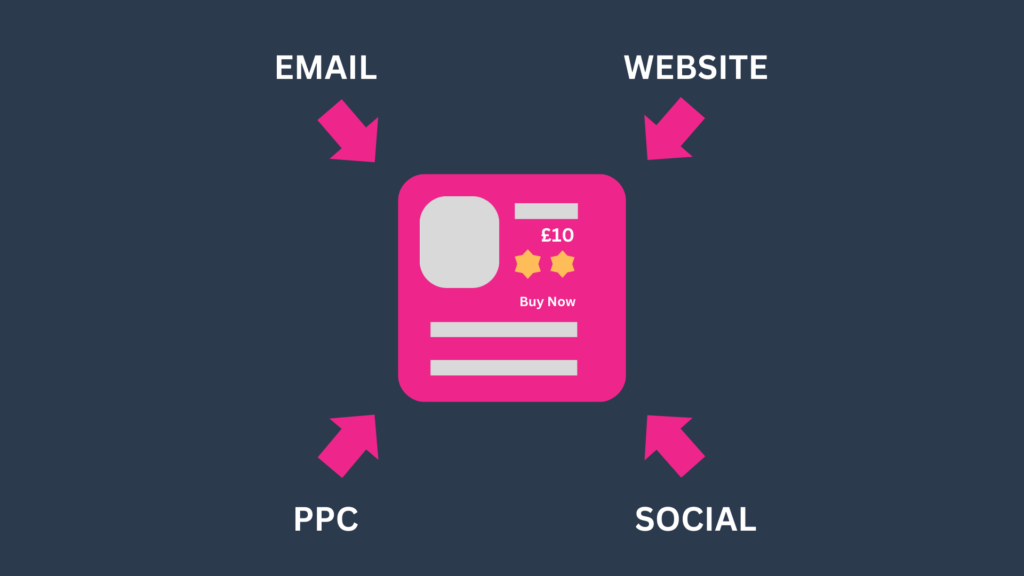
A product detail page is the endpoint of your traffic driving marketing tactics.
The ecommerce equation
To show how this works, let’s take a step-back for a moment and look at the theory behind successful ecommerce. When we think of how we create a successful ecommerce strategy we can use the following formula:
Revenue = Traffic x Conversion x Price
In other words, your online sales revenue will be a result of the traffic you drive to your products, multiplied by your conversion rate and the price of your product.
Here’s an example of it action:
Imagine you are selling a product on your website for £5. 100 people visit the product page on your website and 1% of those visitors convert and go onto buy your product. You’ll have a revenue of £5.
£5 = 100 x 0.01 x £5
Now, let’s say you set yourself a new target. You want to double your revenue to £10 without changing your product price. You now have two options. You can double the number of visitors (traffic) to your website to 200 or you could double your conversion rate to 2%.
In these cases, the ecommerce equation has been changed to:
£10 = 200 x 0.01 x £5
OR
£10 = 100 x 0.02 x £5
So, to get to our revenue target, without changing the price, we can make two changes. We can improve traffic and we can improve conversion.
But ask yourself which is the easier of these are the easier changes to make?
Paid traffic is expensive, while organic traffic can take a long-time to build. In most cases improving conversion by optimising product detail pages is a great low-hanging fruit with which to increase your revenue.
And the best part.
Once it’s done it’s done.
Your well optimised product pages will be live and making the most of any traffic you drive to them.
Now, every visitor you send to your product detail page will now have a greater chance of making a purchase – making your marketing more efficient.
If you need help creating an ecommerce strategy - get in touch for a complimentary consultation. Our experts will be able to chat through your current situation and provide a path to success.
What should your product detail page include
Every product detail page is different depending on where it is. It could be on your website, an online marketplace or on the website of a distributor. You could have total control over how the page appears or you could be limited to a strict template.
Below we will look at some of the most common elements of a product detail page, and discuss how to optimise them to improve conversion.

A product detail page from Bose with all the key elements of a well-optimised page.
Hero Image
In most cases the main product image will be the first thing a visitor to your pages sees. As with all first impressions you must make it count.
A good first idea is not to use a picture of your product as people would see instore. People shop differently instore and online and your image should reflect this.
In fact, a well optimised online pack shot has been shown to give a sales uplift of up-to 24% over a non-optimised offline pack shot.
When choosing your hero image it should be big and clear. Ideally, you want to clearly show the 4Ws
- Who is the brand?
- What is the product?
- Which variety is it?
- What’s the quantity?
These have been shown by research from Cambridge University to be the most important elements in improving conversion.
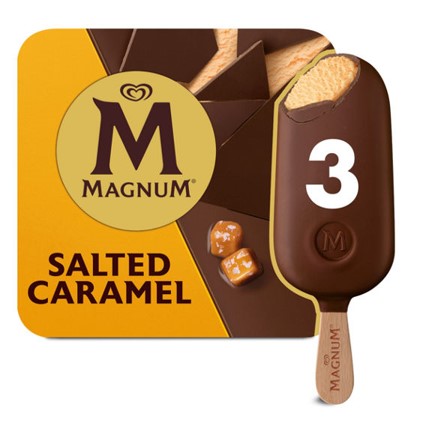
The hero image used by Magnum on online grocery stores. It makes the 4Ws clear and is shows what is inside the pack.
Don’t worry about squeezing on all the terms and conditions that you might have on your normal packaging. These take up valuable space, often are ineligible on mobile. They can also be added to your product copy later.
Once you have a hero image you are happy with a good step is to test it. Use photoshop to place a blur over the image or simply take a few steps back from your computer. Are the 4Ws clearly visible?
If not, you might want to experiment a bit further.
Secondary images
Secondary images are there to support your main hero image. These are images that visitors can click through to explore your product in more detail. Customer expectations have risen dramatically for secondary images, with online shoppers now expecting to see an average of six images when searching online.
This is no bad thing. Imagery allows people to absorb information faster than reading blocks of text, so these are a great tool for signposting the key takeaways you want to highlight.
This could be product benefits, product hygiene factors, what the product looks like from different angles or what is inside the box.
Video
Just like imagery, product videos are a superb way to provide information to your visitor. They are especially useful for showcasing complex product benefits in a digestible way.
Remember what point your customers are in on their journey when choosing a video. They are just about to make a purchase and most likely comparing you to competitor products. Add a video to your product detail page really shows why a customer should pick you.
Product title, bullet points and descriptions
While images are a great way of conveying information quickly, text still provides the best format for allowing customers to dig deeper.
It also increasingly plays a major role in finding your product online. You can think of this a little like how SEO works for a website. When people search for a product online, they might search on google or on a ecommerce store directly. This means your text should include the words people are using to search for your product online. You can think of this as Marketplace or Digital Shelf SEO.
Product copy will come in three main formats
- Product title
- Product bullet points
- Product description
Your product title is the most important of these elements. It will not only appear on the product detail page, but also the search engine results page (SERP) when people are navigating an online store.
It therefore needs to work in tandem with your hero image to draw people onto your product page. You can then convert them through your supporting content.
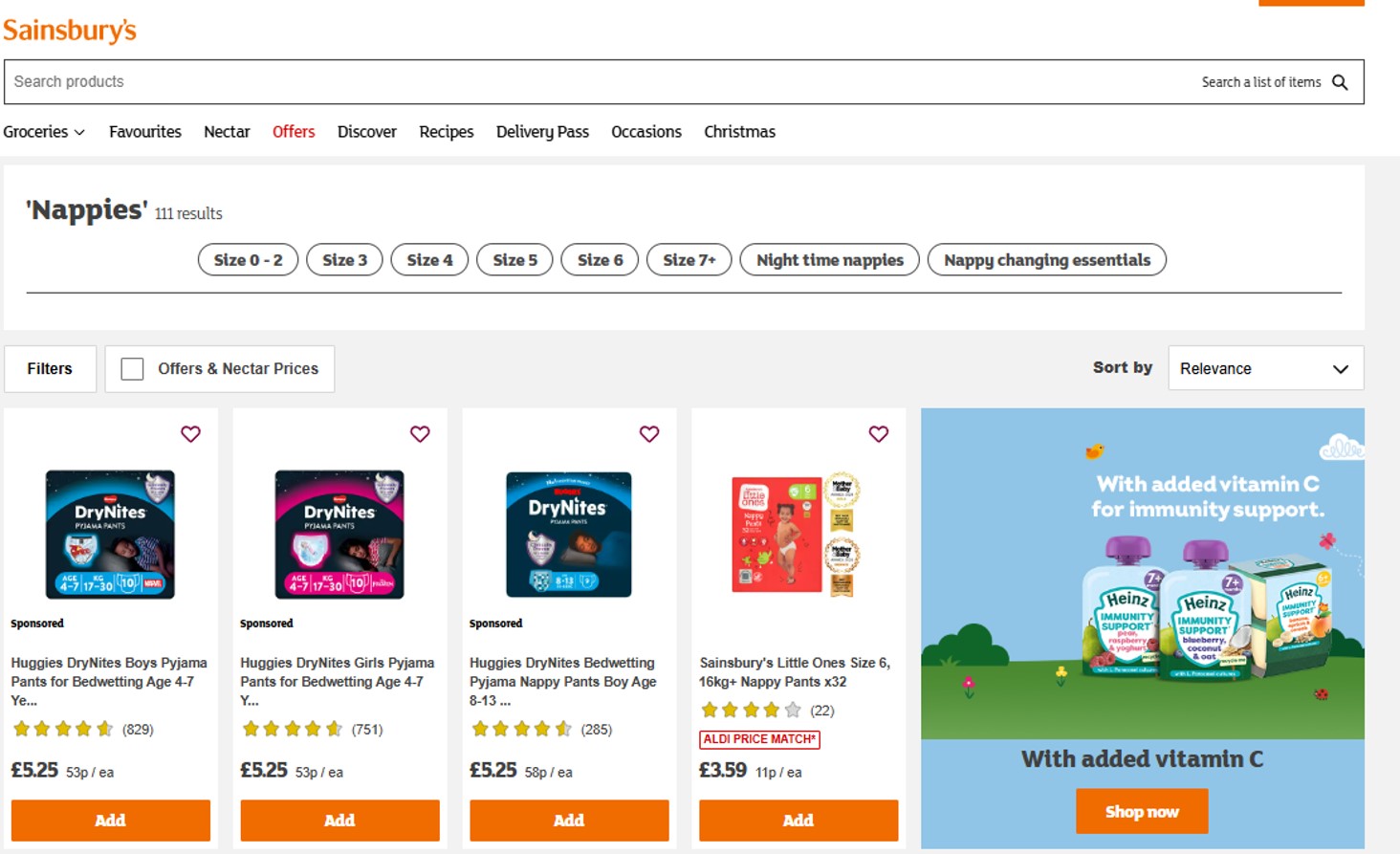
The Search Engine Results Page (SERP) when searching for nappies on Sainsbury's - note only the title and hero image are visible from the SERP
Product bullet points are the next most important element of your copy. These often sit above the fold and just like your secondary images signpost key product benefits.
Dependent on the ecommerce site your product page sits on, your product title and product bullet points will often have quite tight character limits. Think carefully on what you would like to say - you won't have much space to say it.
The final part is your product description. This will sit below the fold (so you have to scroll to see it) and have a generous character limit.
This makes it the ideal space to include any other supporting information you have on the product that people might want to know. This could be product dimensions, where it is manufactured or other hygiene factors that people are willing to spend more time searching for.
Product detail page enhanced content
(referred to as A+ Content on Amazon)
Another type of content that has emerged recently is enhanced content. This is often a mix of images and text that sits below the below the fold and gives customers more information about the product.
On some platforms it can function a little bit like a mini webpage – giving the brand creative control over how they fill the space.
Just like product descriptions this is great place to go into further detail, or to reinforce product benefits in a format with fewer constraints.
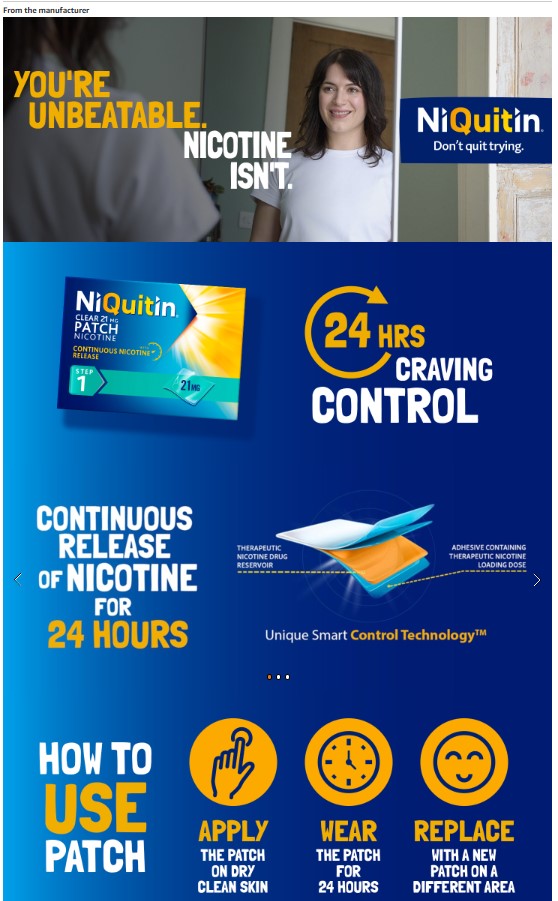
An example of NiQuitin Enhanced Content (A+ Content) on Amazon. This will sit below the fold and is a powerful place to add further brand signals to engaged customers.
Reviews
Social proof is key influencer when people are making a purchase decision. People are social creatures and like to follow the opinion, advice, and behaviour of others when making a decision – even if the decision is different to one they might have reached by themselves.
Reviews and testimonials are a great way to play into this part of human nature. They show other people have purchased the product and it has delivered on their expectations.
Incredibly, according to Matt Moog the CEO of Power Reviews, just going from zero review to one increases the rate at which online shoppers click the buy button by 65%.
Unfortunately, generating reviews is not as simple as writing a new product title or creating a new hero image.
But it can be done through a few different ways. The first tactic for small businesses is to simply ask. This can be done verbally or through an email campaign.
If you need to operate at scale then there are other options. Review generation platforms such as Trustpilot or feefo can be a great way to continuously create new reviews. While platforms, such as Bazaarvoice can share your reviews across multiple ecommerce sites.
Categories and tags
In our experience this is the most overlooked part of optimising product detail pages. Yet one of the most important to fix.
When uploading your products either to your own website or a third-party marketplace/eRetailer you’ll have to select the category your product page should belong too, as well as product tags.
Product categories are the way an ecommerce website can tell where your product should be listed in the website’s menu and breadcrumbs.
For most products this is reasonably simple. Headphones belong to the category Electronics > Audio> Headphones. But in other categories it can be less clear. Does a moisturiser sit better under face care or body skin care?
In these cases, you would have to weigh up both the search volume for the keywords in each category and which category your product would sit more naturally in. Or, you try to get your product detail page listed in both categories.
Having a product in the wrong category can have a serious impact on your conversion rate.
The next part of this puzzle is how your product is tagged. These inconspicuous parts of the form when you submit new products to third-party ecommerce sites are absolutely vital to the visibility of your product detail page. They are linked to the filters customers use when refining searches online, so a failure to fill them in can result in your product not appearing when results are filtered.
The exact product tags vary significantly depending on your product category. For example, when searching for shirts you might filter by colour or fabric type. While, when searching for skin care you might filter by allergens or scent.
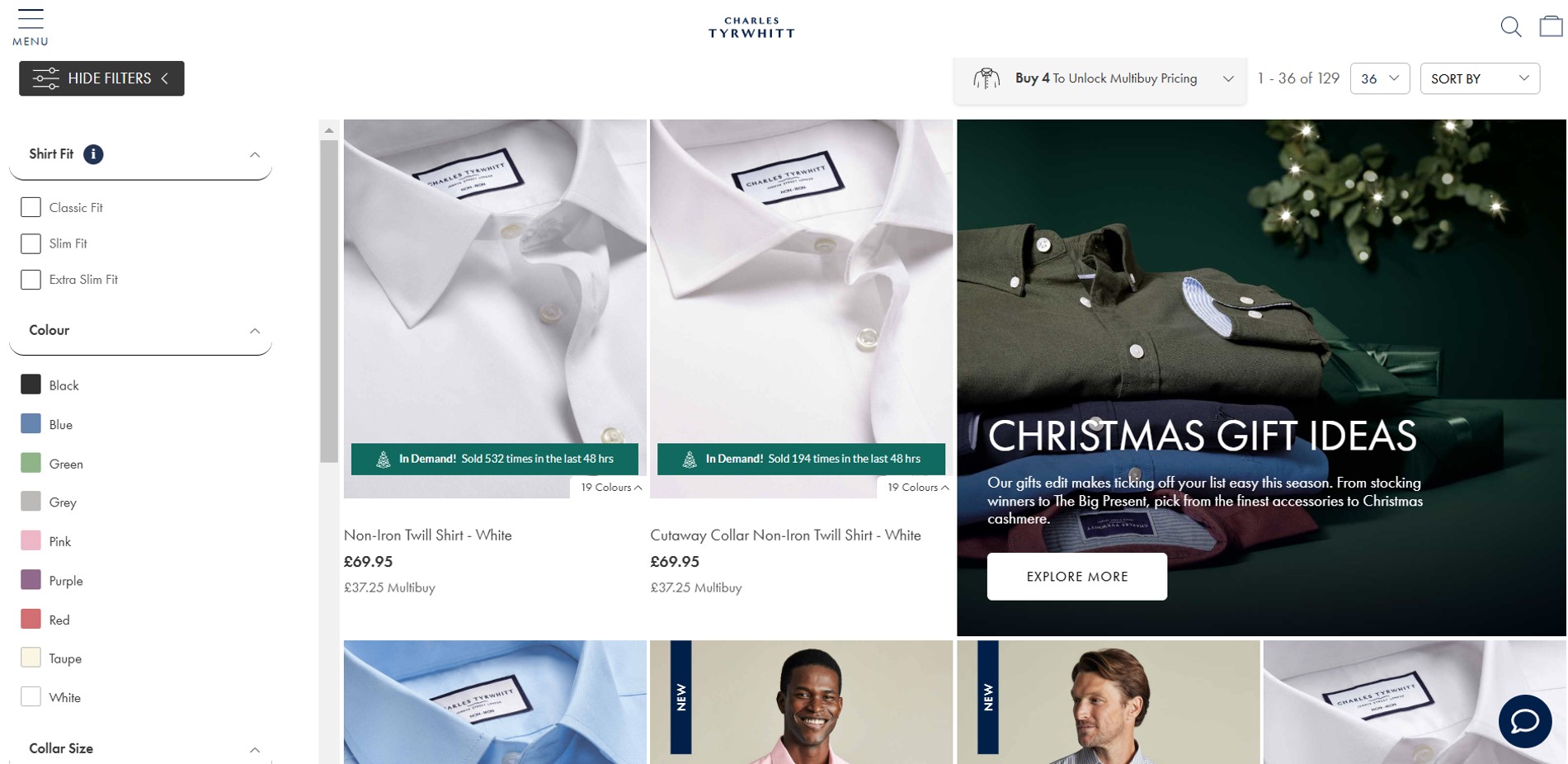
The filters down the side of the SERP are an important way customers search for products. Ensure your products are tagged correctly to appear. Charles Trywhitt, in this example, have identified colour as an important way shoppers navigate the category.
Shipping information
The longer you have to wait for a product, the weaker the proposition becomes. Google has termed this the power of now.
Customers want clear indicators their product will be delivered promptly and with the minimum of friction.
If your product has fast delivery or a frictionless buying process, making this clear on your product detail page you can provide customers a powerful reason to purchase your product over a competitor. Even if the customer views the competitor product as superior.
Our top tips to creating a product detail page that converts
Including everything above is a great first step to creating a product detail page that converts.
However, your competitors are almost certainly including all these elements as well. What will make your product detail page stand-out is excellent execution. Here are top tips to get ahead of your competitors.
Spend time on your keyword research
Keyword data is a superb insight into the mind of the consumer. It tells us not just what they are searching for, but how they search and what questions they have.
You can use keyword research to inform everything from the words you use in your copy to the benefits you highlight. This makes it an essential part of improving conversion on your product detail page and your product detail page's SEO.
Top Tip: the words consumers use to search ecommerce sites are different to how they would search on a search engine. Tool such as keywordtool.io, Stackline Atlas or Helium 10 are all useful for this work.
Less is more with secondary images
With secondary images it easy to get carried away. We see blank space and there is the compulsion to fill it. Remember that your images will be viewed on mobile, and the detail will be lost. So be brave.
A good principle here is each secondary image should have only one key message to the consumer. Anymore risks the message getting lost.
Top Tip: If you’re unsure about how to create secondary images that improve conversion, Cambridge University have published a good set of principles to follow.
Match the product detail page content to the product type
Products are all different and so there is no one perfect product detail page. There is a set of best practices to follow, but these should be informed by your product and the product category.
For example, 360-degrees secondary images work great for products that customers want to see from all angles. Think about purchasing a lamp online. You won’t only see it straight-on in your house, so seeing in 360-degrees online is an important part of your purchasing decision.
Compare this to buying a pack of fish fingers. They come in a box and will live in your freezer. Does seeing this product in 360-degrees make you more likely to purchase them? Probably not. Here the secondary images would be better used to highlight product benefits – sustainably caught, ready in 10-minutes.
In other words, focus on the content that will improve your conversion.
Fill in everything
When creating a product detail page you’ll most likely be filling in a template. This might be directly in the CMS of a website, a portal or even just an excel spreadsheet.
If you see a blank, try your best to complete it. They can be tempting to leave, after all how often does it ever get checked? But filling in all the categories and tags can have a very real impact on your product conversion and traffic. An extra few minutes here can have a big impact.
A/B Test your content
A great part of ecommerce is the amount of real data you can get from your customers and the way they shop. This gives you the opportunity to go back and further fine-tune your product detail page once they are live – further improving conversion rates.
This can be done on both your own ecommerce platform and third-party ecommerce sites. On your own website tools like AB Tasty allow you to run A/B tests. While Amazon have introduced A/B testing to their platform through their ‘experiments’ feature.
Top Tip: If you aren't able to A/B test on a third-party retailer. Run the experiment on your own website or on Amazon using their 'experiments' feature. Then apply your learnings to other retailers.
Think how the product page detail appears on the digital shelf
Your product detail page is not a standalone page. It is the final part of the customer journey from trigger to purchase. While some visitors will go directly to your product detail page, many visitors will land on your page from the digital shelf.
Think of digital shelf in the same way as a physical shelf. Your product will be listed next to hundreds of other products, and it is the job of your product detail page to help it stand out. There are lots tactics to win the battle for visibility on the digital shelf from great content to ecommerce SEO or good old-fashioned effective promotion. But a well-optimised product detail page should be the basis of your strategy.
If you are thinking looking for a ecommerce marketing consultant to develop your digital commerce offering and would like to discuss your options - get in touch and book a complimentary consultation with one of our marketing experts. We will be able to chat through possible approaches to your marketing and advise you on next best steps.
Book Your Complimentary Marketing Consultation
Do you need ongoing support with your marketing or help with a one-off project? Get in touch to book your complimentary consultation with one of our marketing experts. We'll discuss your needs together and start your journey towards better marketing. Book Your Appointment
